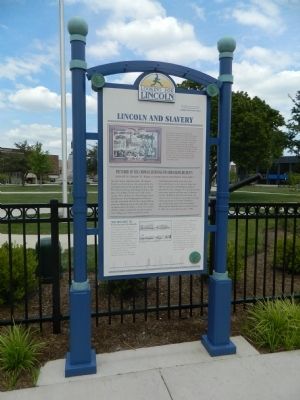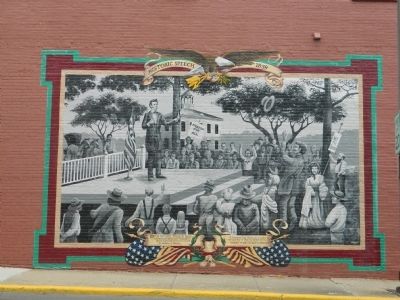Lincoln and Slavery
Looking for Lincoln
Pictured in the crowd listening to Abraham Lincoln's speech is Joseph O. King, a prominent merchant who later became mayor of Jacksonville. He helped found a political group that agitated for the exclusion of slavery from the free territories. Their first meeting, with King as clerk, took place in his store on the north side of the square. Most of the men who belonged were abolitionists. The Congregational Church was the only local church that supported this position. King's group purchased 500 copies of Harriet Beecher Stowe's Uncle Tom's Cabin (1852), widely considered an inflammatory novel. King and others caused havoc by distributing the books in Jacksonville. Remembering Lincoln's speech, King said, "We had only a few real Republican addresses before the Fremont campaign. One of the first strong anti-slavery speeches made here was by Abraham Lincoln. He spoke in the court house park, and when he came out sharp and strong against slavery i threw up my hat and shouted 'Hurrah for Abe Lincoln for president of the United States.'" Although the Republicans lost with Fremont in 1856, they won with Lincoln in 1860.
Lincoln gave a strong speech against the Kansas-Nebraska Act on the Jacksonville Square the evening of September 2, 1854. Penned by Stephen A. Douglas, this Act allowed a territory to decide whether
it would be free or slave. It became known as the doctrine of 'popular sovereignty." Lincoln stood unalterably opposed to the extension of slavery to the territories. When Lincoln became a key figure in the Republican Party of Illinois, he spoke at a Fremont for President rally held in Jacksonville. A nearby wall mural depicts this mass meeting in the Court House yard.
These views depict the North and East sides of the Jacksonville Square in 1861. unlike most towns, Jacksonville did not locate its County Court House in the middle of its Square. The original Court House stood on the northwest corner of the Square. After this structure burned, the county built the brick building shown in the mural. It was regarded as one of the ugliest courthouses in the State of Illinois. Stephen A. Douglas served briefly here as Morgan County State's Attorney beginning in 1836. Although Lincoln was a lawyer on the Eighth Judicial Circuit, which did not include Morgan County, he appeared numerous times in cases tried in the brick courthouse. It was demolished after the current Second Empire Court House was constructed two blocks west of the square on State Street in 1868.
Topics and series. This historical marker is listed in these topic lists: Abolition & Underground RR • Government & Politics
Location. 39° 44.059′ N, 90° 13.752′ W. Marker is in Jacksonville, Illinois, in Morgan County. Marker is at the intersection of State Street and Main Street on State Street. Touch for map. Marker is in this post office area: Jacksonville IL 62650, United States of America. Touch for directions.
Other nearby markers. At least 8 other markers are within walking distance of this marker. 1858 Senate Race Here (here, next to this marker); Potawatami Indians (within shouting distance of this marker); Greene Vardiman Black (within shouting distance of this marker); The Farmers State Bank and Trust Company (about 300 feet away, measured in a direct line); New Method Book Bindery (about 500 feet away); William Jennings Bryan (about 600 feet away); Lincoln and Jaquess (approx. 0.2 miles away); a different marker also named Greene Vardiman Black (approx. 0.2 miles away). Touch for a list and map of all markers in Jacksonville.
Credits. This page was last revised on August 2, 2020. It was originally submitted on July 20, 2012, by Bill Pfingsten of Bel Air, Maryland. This page has been viewed 721 times since then and 16 times this year. Photos: 1, 2. submitted on July 20, 2012, by Bill Pfingsten of Bel Air, Maryland.

